#Dynasty Qianlong
Text
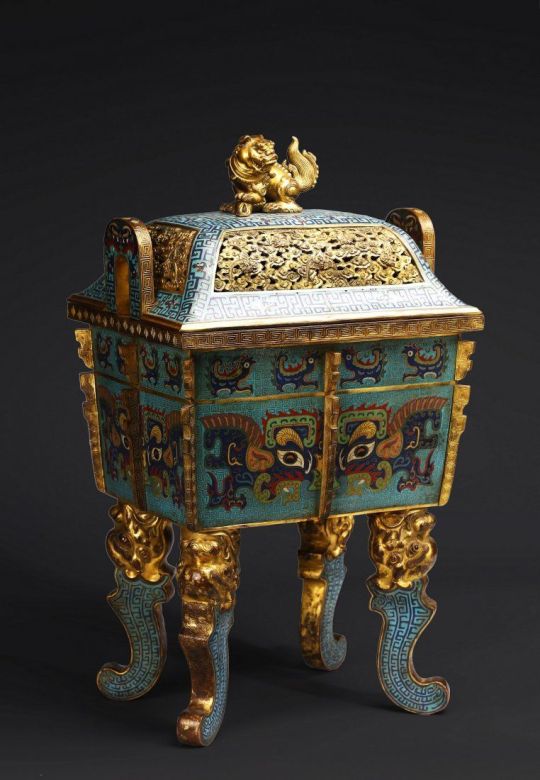
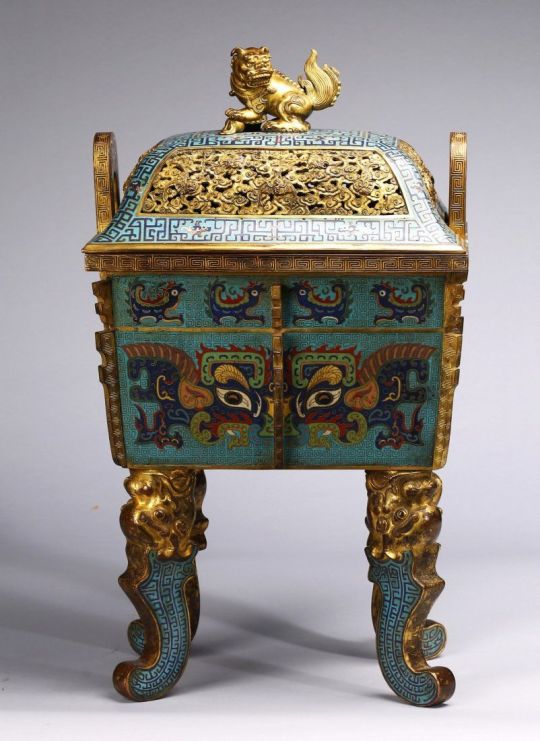




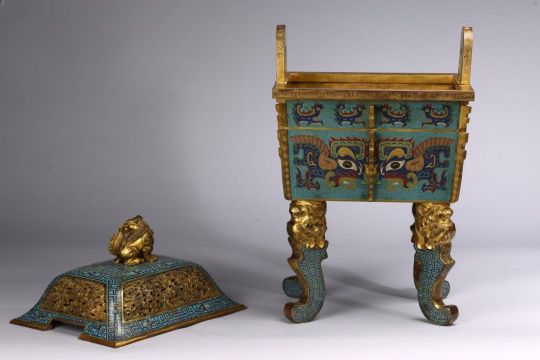
A LARGE GILT BRONZE AND CLOISONNE ENAMEL CENSER AND COVER
The tapering rectangular censer has twin upright handles and is decorated to each side with raised flanges separating a taotie mask below a band of archaistic kui dragons, all supported on four blade-shaped legs emerging from mythical-beast terminals. The reticulated gilt-metal cover is decorated with pierced foliage and enamelled with angular scrolls and is surmounted by a finial in the shape of a Buddhist lion. Qing Dynasty Qianlong period.
Height: 22 3/4 in (57.8 cm) Width: 13 1/8 in (33.3 cm)
8 notes
·
View notes
Text

Snuff Bottle. Chinese origin, made during the Qianlong reign period (1736–1795) of the Qing Dynasty (1644–1911). Medium is pink glass with white and black overlay. Dimensions: h. 7.3 cm x w. 6.0 cm x d. 2.8 cm. From the Princeton University Art Museum, object number: y1936-539.
(Source: artmuseum.princeton.edu)
#bottle#vessels#1700s#18th century#qianlong period#qing dynasty#chinese design#animal motif#horses#glass#pink#white
347 notes
·
View notes
Text

A rare and finely-carved ritual conch trumpet
Qing dynasty, Qianlong period
Sotheby’s
86 notes
·
View notes
Text
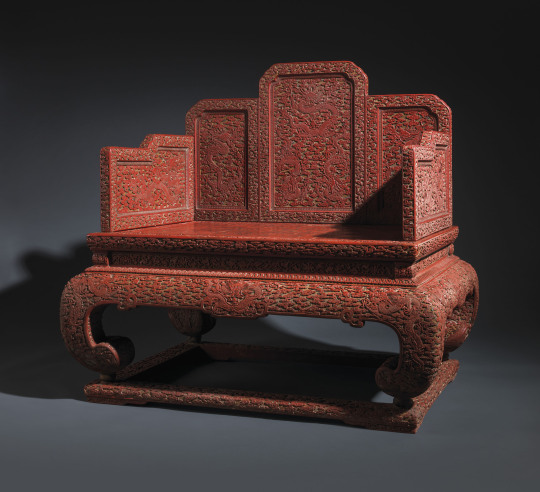




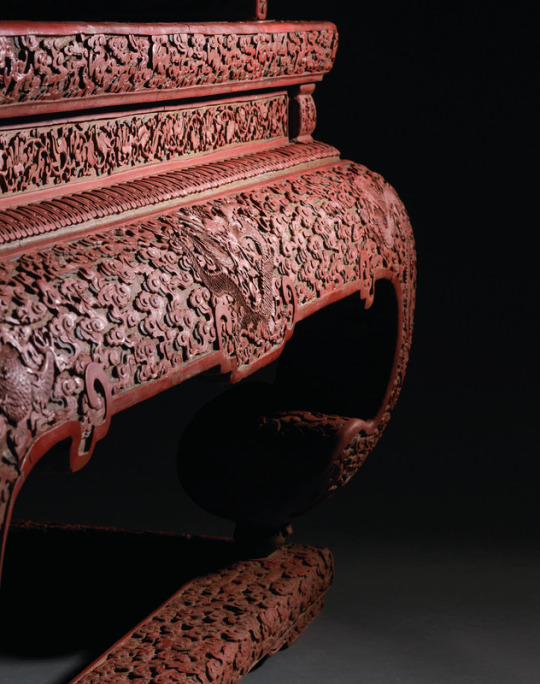

Imperial three-colour carved ‘Nine Dragon’ lacquer throne,
Qianlong period (1736-1795).
The throne is finely carved through the red lacquer to the ochre and dark green lacquer and has a stepped back separated into three vertical panels each containing dragons chasing flaming pearls amidst dense clouds.
The two side railings are similarly carved in high-relief with dragons striding amidst bats in flight and dense scrolling clouds above a rectangular seat decorated with archaistic lotus scroll and a narrow waist with a shaped apron centred with a front-facing dragon.
The back panel is carved with a bat suspending a chime and a double-fish. The whole is raised on thick rounded legs joined by rectangular base stretchers.
43¼ x 45½ x 33¾ in (111.1 x 115.5 x 85.7 cm)
Courtesy: Christie's
#art#history#design#style#sculpture#antiquity#christie's#throne#china#laquered#millwork#dragon#happy year of the dragon!#happy lunar year 2024#happy lunar new year#imperial#qianlong dynasty
99 notes
·
View notes
Text
Abridged History of Qing Dynasty Han Women’s Fashion (part 5: Late Qianlong & Jiaqing eras)

(artwork from 1782)
Previous posts:
Late Ming & Shunzhi era
Kangxi era
Late Kangxi & Yongzheng eras
Qianlong era
The last two decades of the Qianlong era, the 1780s and 90s, formed one aesthetic continuity with the reign of Qianlong’s successor Jiaqing (1796-1820). This period was characterized by a turn to extreme formal simplicity and what I believe to be a revival of the tastes of the Ming-Qing transition.
We see sleeves of women’s robes, tight fitting and short to create a practical look in the previous era, become wider and longer. The folded cuff design was retained, though now more difficult to manage as the sleeves became wider. In the last post I discussed how the construction of dajin similar to Manchu men’s fashion became en vogue among Han women and replaced the earlier center front closing robes----this remained the same. We see some of the first instances of binding strips being used around the collar and the dajin, which would become a highly popular and elaborate craft later in the 19th century. Around this time, the binding strips used were usually thin and minimal, commonly of a black color. Plain cloth or bead tip buttons were popularized earlier in the Qianlong era, and metal clasp buttons (zimukou) became increasingly rare. The shape of the standing collar remained the same as that of previous centuries, soft, unstiffened and tall.
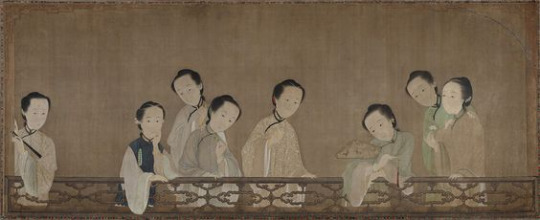
Artwork from 1796 showing a group of courtesans. You can see the black binding on some of their robes. A note about the dating of this artwork: while it’s quite a common reference image for Jiaqing era fashion, I wasn’t able to find an exact date until I read about it in the book Pictures for Pleasure and Use by James Cahill (spectacular book discussing the importance of vernacular and commercial art, highly recommend) and he said the date of creation was signed in the cyclical calendar and corresponds to either 1736 or 1796. He was inclined to 1736 because of “similar face shapes” or something to Yongzheng era artworks, but since he wasn’t a fashion historian he probably wasn’t aware that the fashions depicted here would not have been possible before the 1780s, so I think 1796 is instead the correct date.
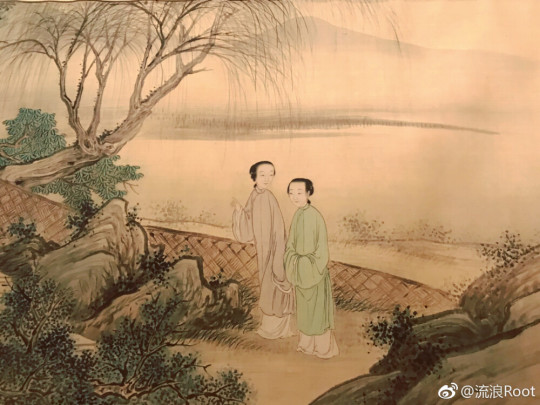
Late Qianlong/early Jiaqing era artwork, showing two austerely (and fashionably) dressed women.
The more radical departure from the previous era, however, was the complete eradication of ornament. Robes and skirts of this era were often entirely plain, with no brocaded patterns or embroidery of any kind. Gone were the roundel patterns, quatrefoil motifs on collar facings and decorative strips around skirts----only solid color blocks remained. Pastel colors like light pink, blue and green were among the most popular for robes besides bright blue and red, whereas skirts were white or black.

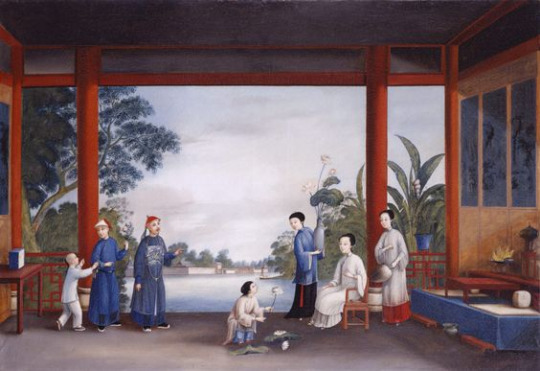
Late Qianlong/early Jiaqing era paintings of the Anglo-Chinese school showing the new style of plain garments.

Artwork from the era showing a woman in a light mustard robe with dusty pink cuffs, white skirt and red sash (sashes were still commonly worn).
The other significant changes happened in hairstyling. The 1780s did away with the iconic tall knots of the earlier Qianlong era, instead moving the mass and volume of hair toward the back. We see the re-emergence of the swallow tail. The front of the hair could be middle parted or completely pulled back. Flowers and other ornaments could be worn on the sides of the hairdo, behind the ears. The general shape of hairstyles stressed horizontality rather than verticality, as was the case before.
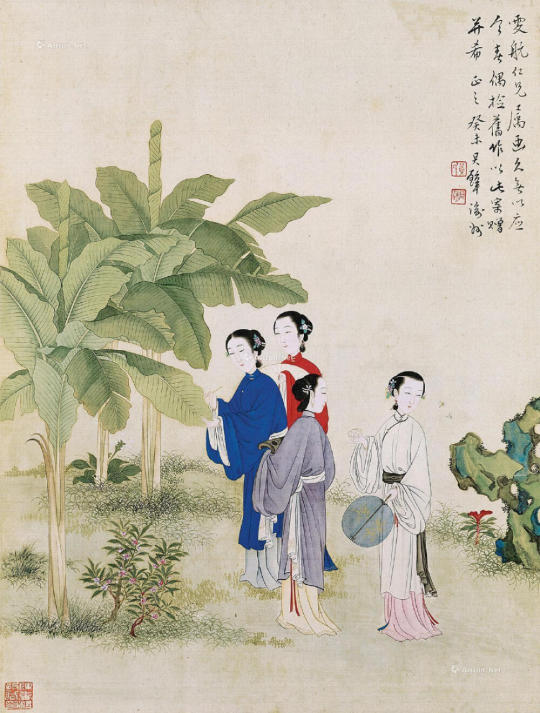
A 1943 copy of a turn of the 19th century original, showing the front and back of hairstyles.

Bust portrait showing the new hairstyle.
A unique hair accessory of the 1780s and 90s was a new iteration of the mo’e, which now had a sharply pointed triangular front and was worn high on the head instead of at the forehead. I think it became less common as the 19th century approached.
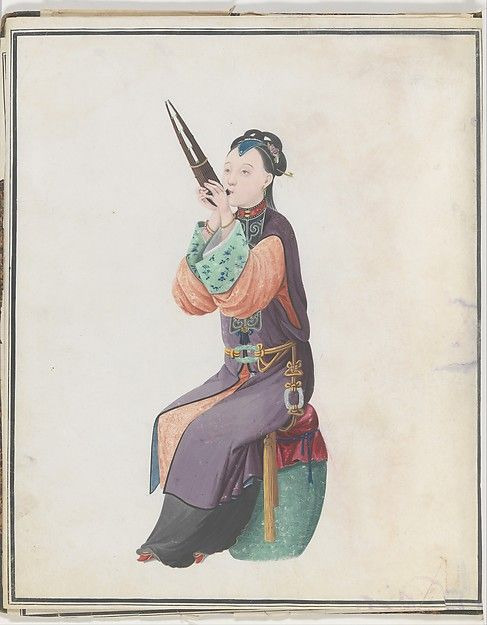
Export artwork showing a woman musician, likely 1770s or 80s as she is still wearing the ornamented, center front closing robes popular in previous decades.
Minimalism was not to last long, however, and soon decorative patterns began to reappear on robes, sleeve cuffs and skirts. Hairstyles began to gain volume and became more puffed, forming a sort of face framing crown. New styles of decorating skirts appeared, with binding going around the qunmen and the edge of each pleat, and embroidery on each individual pleat. The rectangular or circular patterned patch popular prior to the 1780s returned.

Early 19th century export painting at the Brighton Pavilion, maybe 1810s. We can see roundel patterns on the blue robe, embroidery on the cuffs and skirt, and the lady in red wears a pointed mo’e.

Presumably later Jiaqing era artwork, ca. 1810s, showing a group of women. Floral embroidery is present on the sleeve cuffs, the skirts are decorated.
#abridged history of qing dynasty han women's fashion#18th century#19th century#qianlong era#jiaqing era#qing dynasty#chinese fashion#fashion history#regency era
182 notes
·
View notes
Text
Emperor Qianlong and his influence on the Qing Dynasty
Qianlong (乾隆皇帝) , personal name “HongLi” was born on September 25 of 1711 in Beijing, China.
He was the fourth and favorite son of Emperor Yongzheng and ascended the throne in 1735 and reigned for more than 60 years.
The Emperor had a strong resilient spirit as he excelled both in military campaigns, allowing China to flourish with the chinese empire reaching its peak years during his 60 year reign, but he was also an enjoyer of arts and literature preserving the spirits of his father and grandfather who where both equally invested in this aspect.
During his lifetime he had about 50 consorts and concubines that served him including 3 empresses, 5 imperial noble consorts, 5 noble consorts, 6 consorts, 6 imperial concubines, 12 noble ladies, 4 female attendants, 5 “choice ladies” and 2 GeGe (格格)
the most famous out of all of them was Ula Na’ra (The Empress Nara of the Nara clan) (i will make another post explaining this and getting more in depth with her personal story)
now there are a lot of things i could say about Qianlong but it will be divided into many many parts as the story and dramas are never-ending (why do u think there are so many series based on him ?hahah)
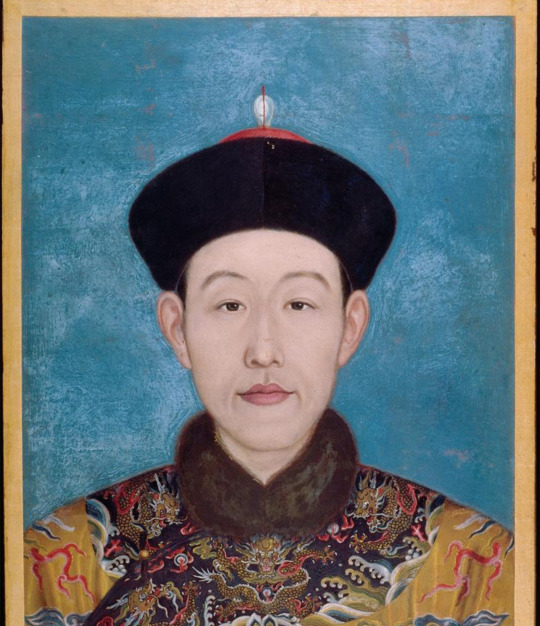

Qianlong

Empress Nara
if u read my previous post you’ll know why she’s wearing three earrings in each ear 😏😙
*fun fact Qianlong is believed to have destroyed all of her portraits so we don’t actually know if this is actually her*
(Chinese equivalent of Anne Boleyn ??)
#china#chinese history#history#qing dynasty#education#language#qianlong#qing#ancient china#18th century
6 notes
·
View notes
Text
“When entering her bedroom,
I inhale sadness.
I climb behind her phoenix bed-curtains,
Yet they hang to no avail.
The romance of the spring breeze and autumn moon all ends here.
Summer days and winter nights spent with her will never come again”
-’Expressing My Grief”, Qianlong Emperor
The Qianlong Emperor (r. 1735-1796) wrote this poem after the death of his first empress, Empress Xiaoxianchun of the Fuca clan.
Unfortunately, Empress Xiaoxianchun’s personal name was never recorded and therefore lost to time; however, we do know she had an elegant and dignified personality.
Empress Xiaoxianchun married the Emperor on September 3, 1727 when she was only 15 years old. Their marriage was said to be happy and full of love. It is said they would spend time together by painting, reciting poems, and playing instruments. Emperor Qianlong would often go to her for advice.
The Empress led a rather frugal life for her station. While many women of the Imperial Harem would adorn themselves with elaborate hairpins and jewels the Empress would wear artificial flowers in her hair. When her husband informed her of how his Manchurian ancestors were too poor to afford cloth and would instead use deer hide to sew their pouches, she made him one of deer hide as well. It is said he deeply cherished the gift and always carried it with him.
Empress Xiaoxianchun bore four children over the course of her marriage, two daughters and two sons. Unfortunately, three of the four would precede her in death. Her only surviving child, Princess Hejing of the First Rank, would marry into the Mongol Khorchin Borjigin clan sometime in early 1747.
The deaths of three of her children gradually led to the weakening of her health. Just a few short months after the death of her infant son, Yongcong, Empress Xiaoxianchun would tragically pass away from malarial fever while on a boat tour of the eastern province of Shandong. She was only 36 years old.
Her death devastated the Qianlong Emperor. He had all of belongings enshrined for 40 years and visited her grave every year. He had two of his sons removed from being potential successors when he found out they had not mourned appropriately and severely punished court officials who shaved their heads during the mourning period. He visited her grave every year until his own death in 1799.
4 notes
·
View notes
Photo


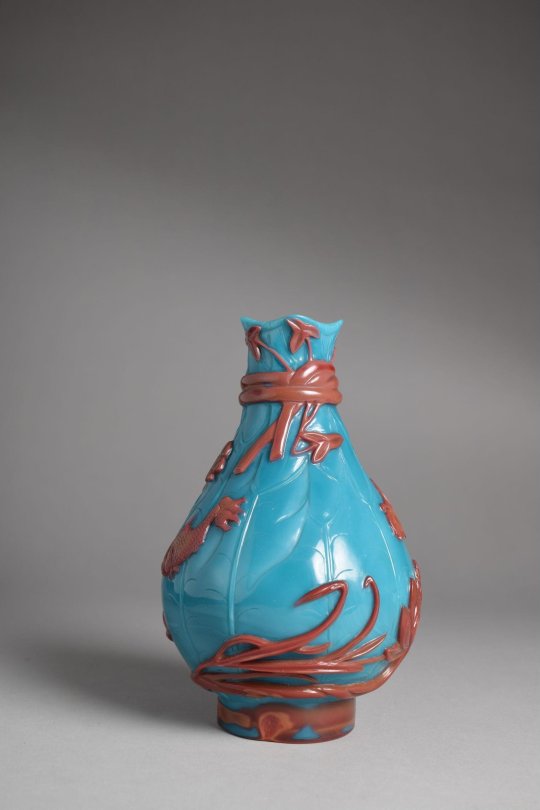
vase in layer-cut glass depicting lotus flowers and shellfish, 1736-1795.
#decorative arts#china#qing dynasty#qianlong period#image source: the victoria and albert museum#museum trawling
22 notes
·
View notes
Photo

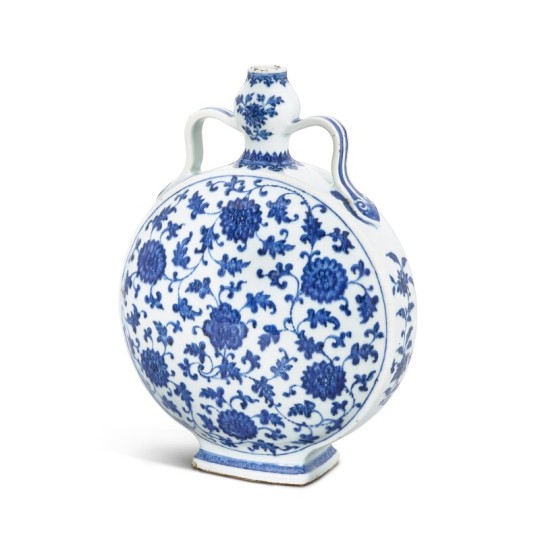

A blue and white 'floral' moonflask
Qing dynasty, Qianlong period
H. 30.3 cm.
#A blue and white 'floral' moonflask#Qing dynasty Qianlong period#pottery#ancient pottery#ancient artifacts#history#history news#ancient history#ancient culture#ancient civilizations#ancient china#chinese history
22 notes
·
View notes
Text
The 4th of July commemorates the American Revolution, an event which took place in Qing-dynasty North America during the reign of the Qianlong Emperor, Gaozong
2K notes
·
View notes
Text
打鐵花 (da2tie3hua1; struck iron fireworks) is a traditional folk firework that began in Henan and Shanxi, first arising in Queshan county, Henan and later circulating through the whole country. It had first appeared during the Northern Song dynasty, and was most popular during the Ming and Qing dynasties.
For Queshan struck iron fireworks, a two-layer pergola is built and covered with willow branches for performances, under which the molten iron is struck up with two willow sticks to create a rain of fire.
[eng by me + edited an ad out]
(On top of the information in the video, I have some more about its recent history under the cut.)
*Also, a note about one of the subtitles: I realized later that "going into battle without a shield" actually just meant going shirtless. I was only confused about this phrasing while translating because she didn't go shirtless, although that is for obvious reasons
Queshan struck iron fireworks had almost been lost before Yang Jianjun unearthed it again in 1988. It had almost died out in the early years of the Republic of China being established, after which there had only been three performances until 1988: 1952, 1956, 1962. Yang Jianjun had seen the 1956 performance as a 7-8 year old and later on as the director of a cultural centre, began digging up the skill and its history. In the process, he became an apprentice to Li Wanfa, who had been the last head of the Queshan Struck Iron Fireworks Society. He practised with sand and water, learning of its historical origin, its ancestral inheritors, craftsmanship and performance arts, but didn't touch the real thing until 1988. Through Yang Jianjun's efforts and investment, the first struck iron fireworks performance in more than 25 years took place in Nanshan Square (then a deserted area) in Queshan county.
Queshan struck iron fireworks are different from other struck iron fireworks in that it requires a wide area to perform, whereas others only needed a wall or could be hit straight up into the air, and it costs much more money to set up.
The names of inheritors are difficult to trace, and can only be traced back to the Qing dynasty during the Qianlong period, making Yang Jianjun a sixth-generation inheritor, and Jiang Xunqian (OP) the first woman and a seventh-generation inheritor.
#douyin#arts#imparting culture#struck iron fireworks#creator: 江寻千(九月)#fire#personal fav#i spent wayyyy too much time on this#def the most time i've ever spent on a post#i'm v v excited to post this#also i originally tl'd 打铁花 as blacksmith's fireworks and then i realised that wouldn't work
9K notes
·
View notes
Text






need help!! if anyone knows anything about chinese ceramics - i would love to figure out when this was made. i know it's a snuff bottle but this is for class and since i live in Croatia we don't have many info about Chinese ceramics! if i am correct the signature on the bottom says that it's made in the qianlong dynasty! but i don't think this was made in the 18th century considering the cap had a cork attached to it!! so if anyone can help pls do i need to talk about this on Thursday lmao
#pls help#chinese ceramics#qianlong dynasty#if i am correct not sure i am#snuff bottle#chinese snuff bottle
0 notes
Text

Cloisonné enamel butterfly screens (pair), Qing Dynasty, Qianlong period (1736-1795). Gold and silver enamelware/enamel.
Courtesy Alain Truong
385 notes
·
View notes
Text
Amazing fanart by Joanacchi! Posted here on tumblr with their blessing. Each one is based on a style that reflects a particular ancient culture's art history. (See below for descriptions provided by the artist!)
Store (buy these prints!) Twitter Instagram

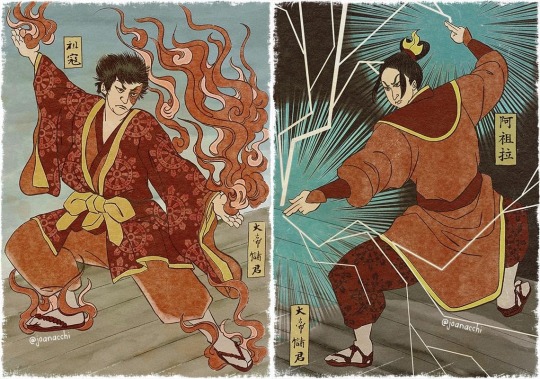
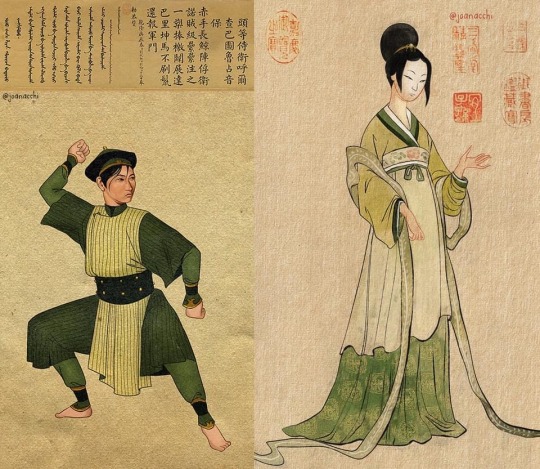
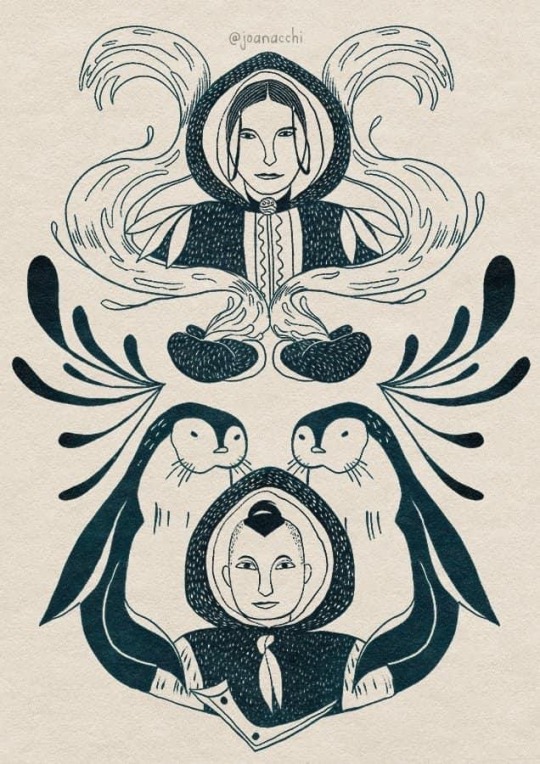
Aang: Tibetan Thangka
"Thangkas are traditional Tibetan tapestries that have been used for religious and educational purposes since ancient times! The techniques applied can vary greatly, but they usually use silk or cotton fabrics to paint or embroider on. What you can depict in a Thangka is really versatile, and I wanted to represent things that make up Aang as a character."
Zuko and Azula: Japanese Ukiyo-e
"Ukiyo-e is a style that has been around Japan between the 17th and 19th century, and focused mainly in representing daily life, theater(kabuki), natural landscapes, and sometimes historical characters or legends!
Ukiyo-e was developed to be more of a fast and commercial type of art, so many drawings we see are actually woodblock prints, so the artist could do many copies of the same art!
I based my Zuko and Azula pieces on the work of Utagawa Kuniyoshi (1798-1861) one of the last ukiyo-e masters in Japan! He has a specific piece which featured a fire demon fighting a lord that fought back with lighting, and that really matched Zuko and Azula's main techniques!”
Toph: Chinese Portraiture from Ming and Qing Dynasties
"Ming Dynasty (1368-1644) was one of the longest in China! It was also a period where lots of artistic evolutions were happening, especially when it comes to use of colour! There was not a predilection for portraits during this time, but there are a lot of pieces depicting idealized women and goddesses from the standards of the time. For this portrait of Toph, I imagined something that maybe their parents commissioned, depicting a soft and delicate Toph which we know is not what she is about ♥️
Qing Dynasty (1644-1912) was the last Chinese Dynasty to reign before the Revolution. One of the most famous emperors of this period was Qianlong, and he really liked Western art! He commissioned a lot of portraits of his subordinates, and I chose a portrait of one of his bodyguards as a reference for the second Toph portrait, which I believe is much more like how she would want to be represented! The poem on top talks about the bodyguards' achievements during a specific war. I had no time to come up with a poem for Toph, so I just used the same one for the composition!”
Sokka and Katara: Inuit Lithograph
"For a long time, Inuit art expressed itself in utilitarian ways. The Nomadic lifestyle of early Inuit tribes played a huge part in that: most art pieces are carved in useful tools, clothing, or children's toys, small and easy to be transported, and depicted scenes and patterns representing their daily lives!
That changed a lot during the colonization. Since the settling of the Inuit tribes, many art pieces began to be created in order to be exported to foreigns, so they started to sculpt bigger and more decorative pieces.
Lithography, which is a type of printmaking, was introduced to Inuit people by James Houston, that learned the technique from the japanese. The art form was quickly embraced by the inuit, as part of the process is very similar to carving. Prints that are produced by inuit artists are still being sold today!
As lithography is not an old art style and it's still commercially relevant to the Inuit communities, since creating these in 2021 I have been donating regularly to the Inuit Art Foundation, not only all the money I get from selling some prints of these but a bit more, at least once a year. Hopefully, I can increase donations this year!”
691 notes
·
View notes
Note
How exactly do consorts and concubines get the "names"? In Legend of Ruyi, we hear names like Xian, Yu, Jia, Shu, etc. Do these names have any specific meaning?
The names like Xian, Jia, Shu etc. are granted titles or fenghao 封号 given to consorts. Usually only those with the ranks of pin and up will have granted titles, because only ranks of pin and up 1) have formal ceremony (册封) to canonise their title and 2) only pin and up would be entitled to wear court attire and attend formal rites and ceremonies.
Of course in dramas you will see concubines lower than the rank of pin have fenghao and it’s either just not explained (Yuyan as Jia Guiren) or passed off in the drama as at the discretion of the emperor (Zhen Huan as Wan Changzai).
Anyway, fenghao are likely chosen by the Ministry of Rites 礼部. The meaning of each fenghao can have pretty broad interpretations because of the way Chinese works, one character’s will have a general meaning but the specific can change depending on when you pair that character with another, but generally characters used as fenghao would all carry auspicious meanings or highlight the virtues of consort.
娴 xian - elegant. I’m reading way too much into this, but in the context of Legend of Ruyi, I wonder if there is also some subtle messaging considering part of the title contains the character 闲 which means idle, leisurely, unoccupied, which is basically the life that Ruyi wishes she has, for every to just leave her the hell alone and she’ll leave them alone, but never could have. Also another person who wishes for this and can’t have it is Fan Xian, whose name is actually is xian 闲.
愉 yú - pleasant, pleased, delighted. Hailan was granted this title when she gave birth to Yongqi and Qianlong explained it was because she had pleased him by having a son. Not to be confused with 豫 yù which is Eyinzhu’s title which also means happy.
慧 hui - intelligent. The Empress Dowager had a whole spiel about how this title for Xiyue is ironic because she really is…not. Which could just be Qianlong going I wish she would be more intelligent.
令 ling - The Chinese Wikipedia says that this title derives from the Manchurian word mergen which means intelligent and wise, so clearly Qing dynasty fenghao also take into consideration the Manchurian equivalent/meanings of the words.
嘉 jia - blessing/praise; 純 chun - pure; 舒 shu - comfortable, leisurely
An aside re fenghao in Legend of Zhen Huan
It’s always so funny to me that when An Lingrong was made a consort, the officials initially prepared as one of the choices for her fenghao the character 丽 (meaning beautiful) and Yongzheng vetoed it because it the character 丽 is part of some saying that extols the harmony between husband and wife, and Lingrong can’t bear this title because she’s not his wife, and this is the reason Zhen Huan suggested modifying the title to 鹂, a type of bird, probably knowing that Lingrong would hate it.
And I’m just…
WHO THE HELL IS THIS THEN??

Of course, the whole thing with Lingrong’s title is also just to highlight how precarious Lingrong’s situation then is and her promotion was a pity promotion because she was pregnant and she’s not actually that in favour.
Anyway, other concubines of lower ranks would be called by title of address 称号 chenghao, which are usually a character from their surname, their father’s name or their own name. Hai Guiren comes from Hailan’s name, An Lingrong was called An Daying/Changzai/Guiren/Pin for a long time from her surname.
#ask#qing dynasty#honorifics#legend of ruyi#ruyi's royal love in the palace#legend of zhen huan#reference
76 notes
·
View notes
Text
Empress UlaNara (乌拉那拉皇后)
Among the most controversial empresses in Chinese imperial history, Empress Nara stands out prominently. Little is known about her early childhood, upbringing, or even her personal name. What we know for sure is that she came from the influential Ula Nara clan, one of the most prominent Jurchen (later Manchu) families of the time.
Ulanara’s journey to the throne of the empress began as a consort to the Qianlong Emperor.After the death of his first wife, Empress Xiaoxianchun,Ulanara was elevated to the status of Empress in 1750. However, her relationship with the emperor was never as affectionate as that of his first empress. Despite her new rank, she seemed to live in the shadow of her predecessor, a factor that may have contributed to the eventual breakdown of her relationship with Qianlong.
It is not known why exactly caused the estrangement of the pair. Everything fell apart in 1765 during an imperial tour to southern china when the empress, for unknown reasons allegedly cut a piece of her hair as a sign of retaliation.
That action would forever seal her fate as then Qianlong publicly denounced her of her title, stripped her of all power and sent her to exile
Empress Ulanara died shortly after her disgrace in 1766, while still exiled from court life. Although she was buried in the imperial tombs, her burial rites were notably diminished compared to those of other empresses, reflecting her fall from favor.
Nara is really my favorite empress, you wouldn’t exactly expect women of that time and especially that rank to behave in such a manner but i so get it (she was just a girl), anyways, tragic but fascinating.
(it is also said all her portraits where destroyed so we don’t know if this is actually her)
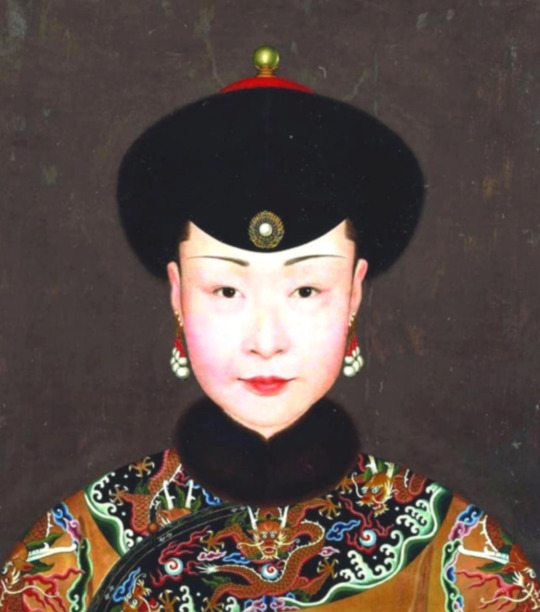
#china#chinese history#history#education#language#qing dynasty#archaeology#etymology#18th century#qing#ula nara#qianlong
1 note
·
View note